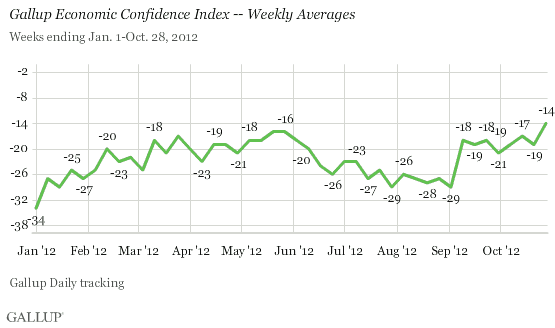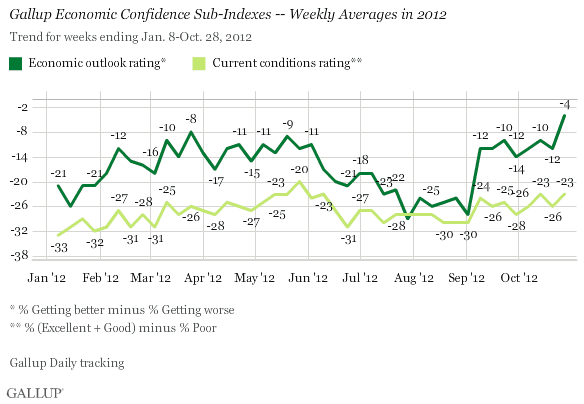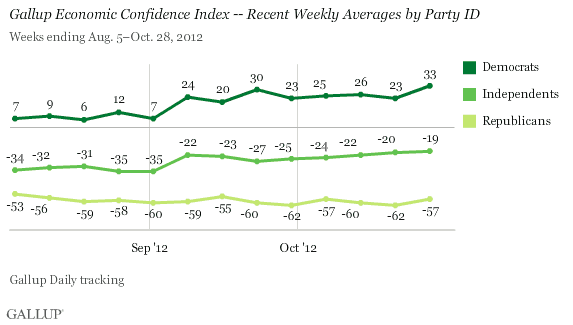WASHINGTON, D.C. -- Gallup's U.S. Economic Confidence Index improved to -14 for the week ending Oct. 28, the highest level of weekly confidence in the economy since Gallup began Daily tracking of economic confidence in 2008.

Prior to the institution of daily tracking in 2008, Gallup measured economic confidence on a periodic basis starting in 1992, including monthly from 2001-2007. And there were many times prior to 2008 when Americans were much more confident about the economy than they are now. However, the current daily tracking data, conducted within two weeks of the upcoming presidential election, are the most positive Gallup has found during the last five years, roughly corresponding to the entire span of the economic downturn.
The uptick in economic confidence last week resulted from an improvement in both components of the index -- one that assesses current economic conditions and the other that assesses the nation's economic outlook. Sixteen percent of Americans say the economy is excellent or good, while 39% consider it poor, resulting in a -23 current conditions rating, up from -26 the previous week.
The -4 economic outlook rating reflects a significant improvement over -12 the previous week, with 45% of Americans now saying the economy is getting better and 49% saying it is getting worse. That is the most positive economic outlook score since 2008.

Economic Confidence Improves Among Democrats and Republicans
Economic confidence improved 10 percentage points among Democrats, to 33, the highest level of confidence by party since Gallup began tracking it. Republicans also saw gains last week, up five points to -57. Despite the improvements among both parties, the two remain sharply divided. Independents had only a slight improvement, up one point to -19.

Bottom Line
Although economic confidence had its best showing since Gallup began Daily tracking in 2008, the majority of Americans still say the economy is fair or poor, and a slight plurality say the economy is getting worse rather than better. While the last few weeks have brought some positive economic news -- such as a decline in unemployment rates reported by both the U.S. Bureau of Labor Statistics and Gallup and, in the past few days, reports of stronger GDP growth during the third quarter -- it is doubtful this news alone will push economic confidence into the net positive range in the coming weeks. Americans will likely need additional signs of consistent economic growth and reasons for improved optimism before confidence will finally cross into positive territory.
Gallup.com reports results from these indexes in daily, weekly, and monthly averages and in Gallup.com stories. Complete trend data are always available to view and export in the following charts:
Daily: Employment, Economic Confidence, Job Creation, Consumer Spending
Weekly: Employment, Economic Confidence, Job Creation, Consumer Spending
Read more about Gallup's economic measures.
View our economic release schedule.
Survey Methods
Results are based on telephone interviews conducted as part of Gallup Daily tracking from Oct. 22-28, 2012, with a random sample of 2,921 adults, aged 18 and older, living in all 50 U.S. states and the District of Columbia, selected using random-digit-dial sampling.
For results based on the total sample of national adults, one can say with 95% confidence that the maximum margin of sampling error is ±2 percentage points.
Interviews are conducted with respondents on landline telephones and cellular phones, with interviews conducted in Spanish for respondents who are primarily Spanish-speaking. Each sample includes a minimum quota of 400 cell phone respondents and 600 landline respondents per 1,000 national adults, with additional minimum quotas among landline respondents by region. Landline telephone numbers are chosen at random among listed telephone numbers. Cell phone numbers are selected using random-digit-dial methods. Landline respondents are chosen at random within each household on the basis of which member had the most recent birthday.
Samples are weighted by gender, age, race, Hispanic ethnicity, education, region, adults in the household, and phone status (cell phone only/landline only/both, cell phone mostly, and having an unlisted landline number). Demographic weighting targets are based on the March 2011 Current Population Survey figures for the aged 18 and older non-institutionalized population living in U.S. telephone households. All reported margins of sampling error include the computed design effects for weighting and sample design.
In addition to sampling error, question wording and practical difficulties in conducting surveys can introduce error or bias into the findings of public opinion polls.
For more details on Gallup's polling methodology, visit www.gallup.com.
